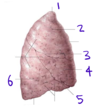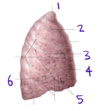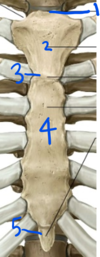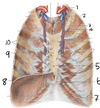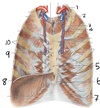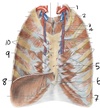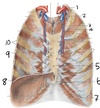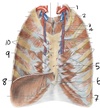FDN2_SM_BodyWall+Cavity Flashcards
List the layers of the body wall from superficial to deep
- Skin
- Superficial Fascia
- Skeletal Muscle/Associated investing fascia
- Celomic lining
What is celomic lining in the thorax called?
Parietal pleura
What is parietal pleura?
The celomic lining in the thorax
What is visceral pleura?
Part of the celomic lining that directly adheres to each lung
What is investing fascia over muscle called?
Epimysium
What is investing fascia over bone called?
Periosteum
What is investing fascia in the thoracic cavity (deep to the ribs) called?
Endothoracic fascia
What are epaxial muscles?
Back muscles (part of the typcial body segment)
What are hypaxial muscles?
Muscles that extend aroudn the celom and form the body wall
Organized into 3 concentric layers
What are the 3 concentric layers of hypaxial muscles, as they present in the thorax?
Which direction do they go?
External intercostal muscles \//
Internal intercostal muscles //\
Transversus muscles (innermost intercostal + transversus thoracis) //\ (similar to intercostal muscles)
Note: Transversus thoracis is deep to the innermost intercostal muscles
What are the 3 concentric layers of hypaxial muscles, as they present in the abodomen?
Which direction do they go?
External abdominal oblique \//
Internal abdominal oblique //\
Transverse abdominis ==
How is the rectus layer of muscle different in the abdomen and thorax?
Abdomen: || (form the 6-pack)
Thorax: absent or vestigial
What is the function of the external intercostal muscles?
Elevate ribs in forced inspiration
Maintain rigidity of intercostal space
What is the function of the internal intercostal muscles?
Depress ribs in forced expiration
Maintain rigidity of the intercostal space
Where does innervation of the external intercostal muscles come from?
Ventral rami
What is the purpose of the rectus abdominus?
Flexes the trunk (like when you do a sit-up)
What is the function of the external abdominal oblique?
Both sides together flex the trunk
Lateral bend and flex
Rotation to the opposite side of the contracting muscle
What is the function of the internal abominal oblique?
Both sides together flex the trunk
Bend or rotate to the same side as the contracting muscle
What is the function of the transverse abdominis?
Compress abdominal viscera
What is the neuromuscular bundle?
Where is it found?
The intercostal nerve, artery, and vein that belong to each intercostal space
The bundle sits in the costal groove, which is sheltered by the distal edge of the upper rib of the intercostal space
When you need to access the parietal pleura, why would you insert the needle just above the rib inferior to the intercostal space?
You want to avoid the neuromuscular bundle, which is associated with the rib superior to the intercostal space
What are the relevant components of the intercostal space?
Boundaries: upper and lower rib
3 concentric layers of muscle (external, internal, innermost)
Each space is associate with a neuromuscular bundle (intercostal nerve, vein, artery)
Describe the path of an intercostal nerve
The intercostal nerve is a spinal nerve
Presynaptic: in CNS
Synapse: in sympathetic trunk
Postsynaptic: Leaves trunk, follows ventral ramus, innervates muscles in the thoracic body wall
Between which two layers of muscle would you find an intercostal nerve?
Between the internal and innermost intercostal muscles





